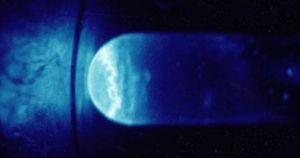The chemical element einsteinium is classed as an actinide metal. It was discovered in 1952 by a project led by Albert Ghiorso.

Data Zone
| Classification: | Einsteinium is an actinide metal |
| Color: | |
| Atomic weight: | (252), no stable isotopes |
| State: | solid |
| Melting point: | 860 oC, 1133 K |
| Boiling point: | |
| Electrons: | 99 |
| Protons: | 99 |
| Neutrons in most abundant isotope: | 153 |
| Electron shells: | 2,8,18,32,29,8,2 |
| Electron configuration: | [Rn] 5f11 7s2 |
| Density @ 20oC: | 8.84 g/cm3 |
Reactions, Compounds, Radii, Conductivities
| Atomic volume: | 28.5 cm3/mol |
| Structure: | close packed cubic |
| Hardness: | |
| Specific heat capacity | – |
| Heat of fusion | – |
| Heat of atomization | – |
| Heat of vaporization | – |
| 1st ionization energy | 619 kJ mol-1 |
| 2nd ionization energy | – |
| 3rd ionization energy | – |
| Electron affinity | – |
| Minimum oxidation number | 0 |
| Min. common oxidation no. | 0 |
| Maximum oxidation number | 3 |
| Max. common oxidation no. | 3 |
| Electronegativity (Pauling Scale) | 1.3 |
| Polarizability volume | 19.7 Å3 |
| Reaction with air | |
| Reaction with 15 M HNO3 | |
| Reaction with 6 M HCl | |
| Reaction with 6 M NaOH | |
| Oxide(s) | Es2O3 |
| Hydride(s) | – |
| Chloride(s) | EsCl3 |
| Atomic radius | 186 pm |
| Ionic radius (1+ ion) | – |
| Ionic radius (2+ ion) | – |
| Ionic radius (3+ ion) | – |
| Ionic radius (1- ion) | – |
| Ionic radius (2- ion) | – |
| Ionic radius (3- ion) | – |
| Thermal conductivity | – |
| Electrical conductivity | – |
| Freezing/Melting point: | 860 oC, 1133 K |

Quartz vial glowing from the intense alpha radiation emitted by 300 micrograms of einsteinium-253. Photo by R. G Haire.
Discovery of Einsteinium
Einsteinium was the seventh synthetic transuranium element of the actinide series to be discovered.
Einsteinium-253 (half-life 20.47 days) was identified in 1952 by teams of scientists from the Lawrence Berkeley National Laboratory, the Argonne National Laboratory and the Los Alamos Scientific Laboratory. The project was led by Albert Ghiorso.
Einsteinium was discovered unexpectedly along with fermium in debris from the first large hydrogen bomb test, which took place in the Pacific on October 31 1952. The debris was collected on filter papers attached to drone airplanes that flew through the explosion area. Later, to obtain more material, many hundreds of pounds of coral from the blast area were examined. Einsteinium was identified by chemical analysis. (1)
The new element was produced by the nuclear explosion in miniscule amounts by the addition of 15 neutrons to uranium-238 (which then underwent seven beta decays). (2)
In 1961 einsteinium was produced in a weighable quantity (0.01 micrograms) for the first time. (3)
The pure metal was isolated for the first time in the 1970s. (3a)
The element is named after Albert Einstein.
Appearance and Characteristics
Harmful effects:
Einsteinium is harmful due to its radioactivity.
Characteristics:
Einsteinium is a synthetic, highly radioactive metal that has only been produced in tiny amounts.
It is the first divalent metal in the actinide series (two bonding electrons rather than three). (3b)
Uses of Einsteinium
Einsteinium is of research interest only.
In 1955 einsteinium-253 was used to create mendelevium for the first time. Less than a picogram of einsteinium-253 was bombarded with alpha particles in Berkeley’s 150-centimeter cyclotron. (4)
Abundance and Isotopes
Abundance earth’s crust: nil
Abundance solar system:
Cost, pure: $ per g
Cost, bulk: per 100g
Source: Einsteinium is a synthetic element and is not found naturally. It is produced in nuclear reactors in miniscule amounts from the neutron bombardment of plutonium. Up to 2 mg can be produced from the High Flux Isotope Reactor (HFIR) at Oak Ridge National Laboratory. (4)
Isotopes: Einsteinium has 16 isotopes whose half-lives are known, with mass numbers 241 to 256. Einsteinium has no naturally occurring isotopes. Its longest lived isotopes are 252Es, with a half-life of 471.7 days, 254Es with a half-life of 257.7 days and 255Es with a half-life of 39.8 days.

References
- Glenn T. Seaborg, The Transcalifornium Elements., Journal of Chemical Education, Vol 36.1 (1959) p39.
- Robert E. Krebs, The history and use of our earth’s chemical elements: a reference guide., Greenwood Publishing Group, 2006., p329.
- Richard G. Haire, The Chemistry of the Actinide and Transactinide Elements., Springer., Vol 3.12, p1577-1578; 3a. p1584; 3b. p1579.
- Jack M. Holl, Richard G. Hewlett, Ruth R. Harris., Argonne National Laboratory, 1946-96., University of Illinois Press, 1997., page 179.
Cite this Page
For online linking, please copy and paste one of the following:
<a href="https://www.chemicool.com/elements/einsteinium.html">Einsteinium</a>
or
<a href="https://www.chemicool.com/elements/einsteinium.html">Einsteinium Element Facts</a>
To cite this page in an academic document, please use the following MLA compliant citation:
"Einsteinium." Chemicool Periodic Table. Chemicool.com. 05 Oct. 2012. Web. <https://www.chemicool.com/elements/einsteinium.html>.
Great website… all the info I needed!